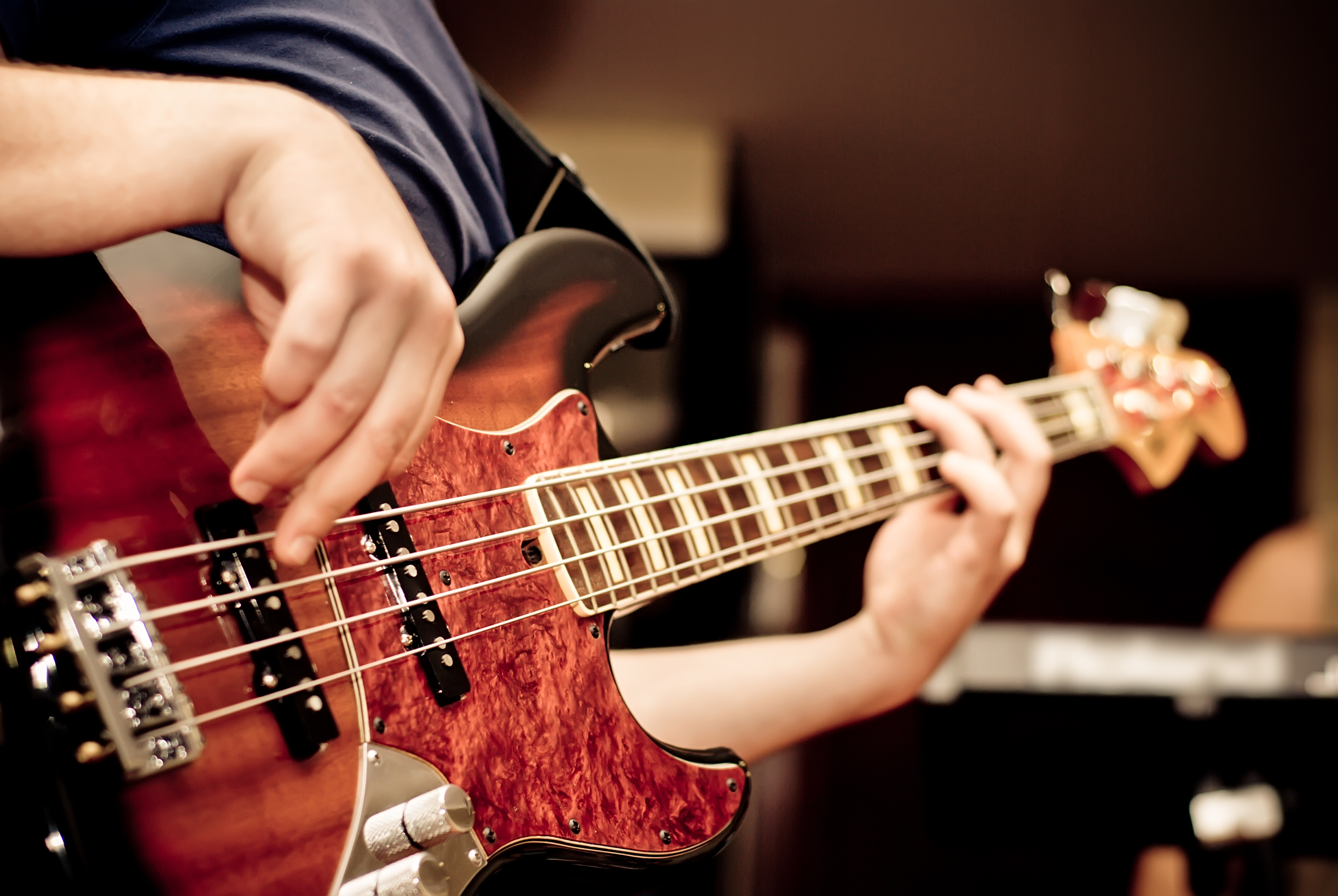Electric bass guitar is an essential instrument in many genres of music, such as rock, pop, blues, funk, and jazz. It provides the low-end foundation and groove for the song, and can also add melodic and harmonic interest. But how do you record electric bass guitar to get a professional sound that fits your style and vision?
There are many ways to record electric bass guitar, but in this post, we will focus on three of the most common and effective methods: direct injection (DI), mic’ing the amp, and using a DI box. We will also give you some tips and tricks on how to get the best results with each method.
Direct Injection (DI)
Direct injection (DI) is the simplest and easiest way to record electric bass guitar. It involves plugging your bass directly into an instrument input on your audio interface or mixer. This method captures the pure and clean sound of your bass without any coloration from pedals, effects, or amps.
DI is great for genres such as pop, blues, and rock, where you want a clear and consistent bass tone that can be easily processed and mixed later. It also avoids any issues with room acoustics, mic placement, or feedback that can occur when mic’ing an amp.
To record bass with DI, you will need:
- An electric bass guitar
- A cable
- An audio interface or mixer with an instrument input
- A DAW (digital audio workstation) software
Here are the steps to follow:
- Plug your bass into the instrument input of your audio interface or mixer. Make sure the input is set to instrument level (not line level) and has enough headroom to avoid clipping or distortion.
- Set up a new track in your DAW software and select the input source as your audio interface or mixer. Arm the track for recording and enable monitoring so you can hear yourself play.
- Adjust the input gain on your audio interface or mixer until you get a strong and clean signal that does not clip or distort. You can use a tuner plugin or a built-in tuner on your bass to make sure you are in tune.
- Press record and play your bass part along with the song. You can use a metronome or a click track to keep time if needed.
- Stop recording when you are done and save your file.
Tips and tricks:
- You can use plugins or effects in your DAW software to shape and enhance your bass tone after recording. For example, you can use EQ, compression, saturation, distortion, chorus, reverb, delay, etc. to add character and depth to your sound.
- You can also use amp simulator plugins or impulse responses to emulate the sound of different bass amps and cabinets. This can give you more variety and flexibility in your tone without having to buy or mic an actual amp.
- You can layer multiple DI tracks with different plugins or effects to create a fuller and richer sound. For example, you can blend a clean DI track with a distorted DI track to get a punchy and aggressive tone.
Mic’ing the Amp
Mic’ing the amp is another popular way to record electric bass guitar. It involves placing one or more microphones in front of your bass amp or cabinet and capturing the sound that comes out of it. This method gives you more natural and organic sound that reflects the characteristics of your amp, cabinet, pedals, effects, and room.
Mic’ing the amp is great for genres such as jazz, funk, soul, reggae, and metal, where you want a warm and dynamic bass tone that has more presence and personality. It also allows you to experiment with different mic types, positions, angles, distances.
To record bass with mic’ing the amp, you will need:
- An electric bass guitar
- A cable
- A bass amp or cabinet
- One or more microphones
- An audio interface or mixer with mic inputs
- A DAW software
Here are the steps to follow:
- Plug your bass into your amp or cabinet and set the volume and tone controls to your liking. You can also use pedals or effects to shape your sound before it reaches the amp.
- Place one or more microphones in front of your amp or cabinet. You can use different types of microphones, such as condenser, dynamic, or ribbon, depending on the sound you want to capture. You can also experiment with different positions, angles, distances, and combinations of microphones to get different tones and perspectives.
- Connect the microphones to the mic inputs of your audio interface or mixer. Make sure the inputs are set to mic level (not line level) and have phantom power if needed.
- Set up new tracks in your DAW software and select the input sources as your audio interface or mixer. Arm the tracks for recording and enable monitoring so you can hear yourself play.
- Adjust the input gain on your audio interface or mixer until you get a strong and clean signal that does not clip or distort. You can use a tuner plugin or a built-in tuner on your bass to make sure you are in tune.
- Press record and play your bass part along with the song. You can use a metronome or a click track to keep time if needed.
- Stop recording when you are done and save your file.
Tips and tricks:
- You can use plugins or effects in your DAW software to further process and enhance your bass tone after recording. For example, you can use EQ, compression, saturation, distortion, chorus, reverb, delay, etc. to add character and depth to your sound.
- You can also use amp simulator plugins or impulse responses to emulate the sound of different bass amps and cabinets. This can give you more variety and flexibility in your tone without having to buy or mic an actual amp.
- You can blend multiple mic tracks with different levels and panning to create a fuller and richer sound. For example, you can mix a close mic with a distant mic to get a balance of direct and ambient sound.
Using a DI Box
Using a DI box is another way to record electric bass guitar. It involves plugging your bass into a DI box, which converts the high-impedance signal from your bass into a low-impedance signal that can be sent to an audio interface or mixer. This method combines the advantages of DI and mic’ing the amp, as it allows you to capture both the direct sound of your bass and the sound of your amp.
Using a DI box is great for genres such as country, folk, indie, and alternative, where you want a transparent and natural bass tone that can be easily blended with other instruments. It also gives you more control over the balance and phase of your bass sound.
To record bass with using a DI box, you will need:
- An electric bass guitar
- A cable
- A DI box
- A bass amp or cabinet
- A microphone
- An audio interface or mixer with instrument and mic inputs
- A DAW software
Here are the steps to follow:
- Plug your bass into the instrument input of the DI box and take a feed from the box into the input of the amp. You can also use pedals or effects to shape your sound before it reaches the DI box.
- Place a microphone in front of your amp or cabinet. You can use any type of microphone that suits your sound preference. You can also experiment with different positions, angles, distances, and combinations of microphones to get different tones and perspectives.
- Connect the output of the DI box to an instrument input of your audio interface or mixer. Connect the microphone to a mic input of your audio interface or mixer. Make sure the inputs are set to instrument level (not line level) for the DI box and mic level (not line level) for the microphone. Also make sure that phantom power is enabled if needed for the microphone.
- Set up two new tracks in your DAW software and select the input sources as your audio interface or mixer. One track will be for the DI signal and one track will be for the mic signal. Arm both tracks for recording and enable monitoring so you can hear yourself play.
- Adjust the input gain on your audio interface or mixer until you get a strong and clean signal that does not clip or distort. You can use a tuner plugin or a built-in tuner on your bass to make sure you are in tune. 6. Press record and play your bass part along with the song. You can use a metronome or a click track to keep time if needed. 7. Stop recording when you are done and save your file.
Tips and tricks:
- You can use plugins or effects in your DAW software to further process and enhance your bass tone after recording. For example, you can use EQ, compression, saturation, distortion, chorus, reverb, delay, etc. to add character and depth to your sound.
- You can also use amp simulator plugins or impulse responses to emulate the sound of different bass amps and cabinets. This can give you more variety and flexibility in your tone without having to buy or mic an actual amp.
- You can blend the DI signal and the mic signal with different levels and panning to create a fuller and richer sound. For example, you can mix a clean DI signal with a warm mic signal to get a balanced and natural tone.
- You can also use phase alignment plugins or tools to make sure that the DI signal and the mic signal are in phase with each other. This will avoid any phase cancellation or comb filtering issues that can make your bass sound thin or weak.
How is Recording Bass Different?
Recording bass guitar is different from recording other instruments in several ways. Here are some of the main differences and challenges that you may face when recording bass:
- Bass frequencies are harder to capture and reproduce than higher frequencies. They require more power and headroom from your audio interface, mixer, speakers, headphones, etc. They also tend to be more affected by room acoustics, mic placement, and feedback issues.
- Bass tones are more subtle and nuanced than higher tones. They depend on many factors, such as the type of bass guitar, strings, pickups, pedals, effects, amp, cabinet, microphone, etc. They also vary depending on the playing style, technique, dynamics, etc. of the bassist.
- Bass tracks are more difficult to mix and balance than higher tracks. They have to fit well with other low-end instruments, such as kick drums, synths, etc. They also have to support and complement the higher instruments, such as guitars, vocals, etc. They have to be loud enough to be heard and felt, but not too loud to overpower or muddy the mix.
Conclusion
Recording electric bass guitar can be a fun and rewarding experience if you have the right equipment and knowledge. In this post, we have covered three of the most common and effective methods for recording bass: direct injection (DI), mic’ing the amp, and using a DI box. We have also given you some tips and tricks on how to get the best results with each method.
We hope this post has helped you learn how to record electric bass guitar to get a professional sound. Now it’s time for you to grab your bass and start recording!


